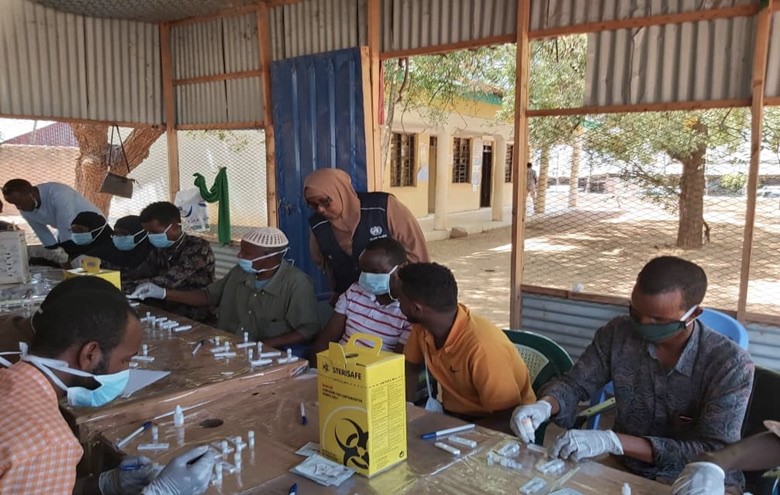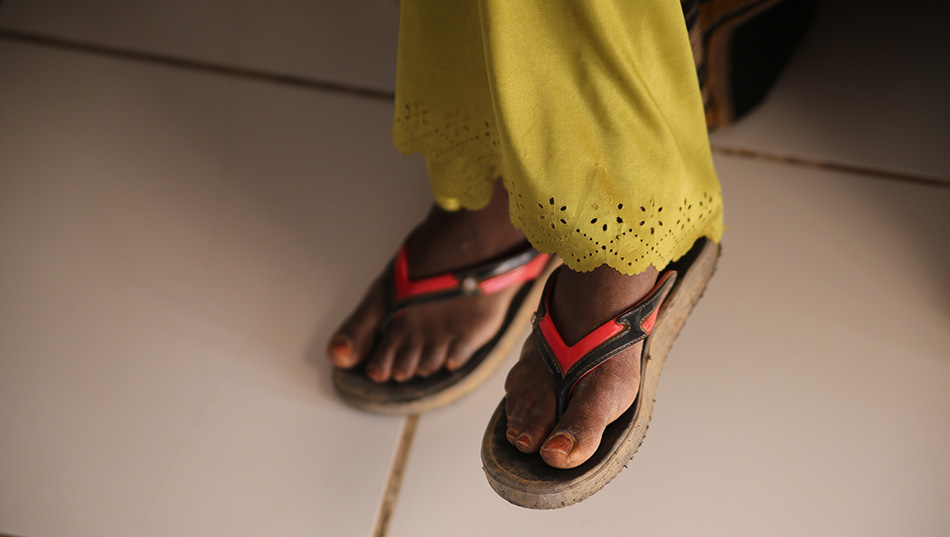 Teams conducting External Quality Assurance for HIV testing to verify quality of laboratory testing in Gedo
Teams conducting External Quality Assurance for HIV testing to verify quality of laboratory testing in Gedo
1 December 2021 - World AIDS Day is commemorated on 1 December every year to shed light on the plight of people living with human immunodeficiency virus (HIV) and acquired immunodeficiency syndrome (AIDS), and the challenges they face. This year’s global World AIDS Day is being held under the theme “End inequalities. End AIDS”. In the Eastern Mediterranean Region of the World Health Organization (WHO), the campaign has “Getting back on track – Focus on testing” as a regional theme in response to the disruption of HIV testing services during the COVID-19 pandemic, with a special focus on reaching the people left behind.
Given that HIV remains a major public health issue and is still a pandemic around the world, WHO is calling on global leaders and communities to rally to address the inequalities that drive AIDS and to try to reach those who do not have access to essential HIV services. The growing inequality, if not addressed, can only fuel and aggravate the divide between those having access to HIV testing and services and those who do not have access to testing, treatment and care.
HIV prevalence in Somalia
Periodic surveys conducted on the prevalence of HIV in Somalia have shown that the rate of infection has been dropping over the last 14 years. The findings of a 2014 survey showed that the HIV prevalence in Somalia had reduced to a level that could be classified as a low-level epidemic in all the states. The most recent survey, conducted during 2018, showed that average antenatal HIV prevalence across the country stood at 0.1% for all states. By geographical area, it was at 0.15% in Somaliland, 0.17% in Puntland and 0.04% in other federal member states. Despite the overall decline, the more dramatic drop in Somaliland, from just over 1.0% between 2004 and 2010, to 0.15% in 2018, meant that for the first time in 14 years of surveys, HIV prevalence in Puntland stood above that for Somaliland.
“The low HIV prevalence in Somalia can be attributed to Somali culture and society, and few risk factors as a result of behaviour,” said Dr Sadia Abdisamad Abdullahi, National HIV/AIDS Programme Manager.
Despite the general decline in HIV prevalence across Somalia, there are locations such as Garowe and Bosasso in Puntland where the infection rates have merely levelled off, with the risk of increasing yet again. The next survey among pregnant women is scheduled for 2023.
Salim Musa* – diagnosed with HIV in March 2014 and an advocate for supporting HIV and AIDS patients in Somalia – thinks the HIV rates may be higher in some groups and locations that were not covered in recent surveys. It is fairly easy for Somalis living in urban areas to access HIV tests and antiretroviral therapy (ART) free of cost in 17 health facilities in various states. For those in rural areas, it can be difficult for people to get tested, explains Salim. Most people do not even know about the symptoms of HIV and where to access services. It is usually at a late stage that many people living with HIV contact doctors for support.
Despite the challenges, by September 2021, 3784 patients were receiving ART at the 17 health facilities spread across different states, 72.5% of whom were already on the newer, more effective dolutegravir-based regimens.
Families, workplaces, health care workers and policies are key to bringing about change
Salim feels he was lucky – he credits his father, a doctor, and his well-educated siblings for encouraging him to seek early treatment after his diagnosis, and for giving him the confidence to deal with his struggles in life.
 Persons living with HIV still face a lot of stigma, including in health facilities, in Somalia
Persons living with HIV still face a lot of stigma, including in health facilities, in Somalia
There is still a lot of stigma and shame associated with HIV in Somalia though, Salim adds. Years ago, at his workplace, people treated him very badly, and requested him to work from home so that no one could be in touch with him. This experience isolated him and forced him to leave to look for a more empathetic team. Now, Salim wears many hats – he works with nongovernmental organizations, vulnerable populations, the government, AIDS commissions, and technical advisors to advocate for the rights of people living with HIV. People he speaks to have been fired from their jobs or denied employment over their HIV positive status.
When Salim first visited a health facility to confirm his HIV status, he was surprised to see that the director of the facility, who tested him, was judgemental and overbearing, and did not respect him and other patients.
Salim shares some of the stories of patients he has worked with. One day, he spoke to a lady who was living with HIV and had fractured her leg. She was in excruciating pain. Even though she had enough money, Salim describes, not one doctor from nine hospitals she visited was ready to help her because of her HIV status.
In another case, a lady who was living with HIV contracted COVID-19. She rushed to the hospital when she needed oxygen but, sadly, no one helped her and she died. Another woman was forced to deliver her baby herself right at the doors of a hospital when medical personnel refused to let her in, as she was known to be HIV positive.
“I feel really sad when I hear these stories,” said Salim. “I feel that policy-makers should help enforce systems and oversight mechanisms to ensure that health personnel do not discriminate against any patients at all, including those living with HIV. No one should have to miss out on receiving medical care, and no health personnel should deny anyone services. They are in a profession where they must help others.”
“We must all work together to put an end to inequalities that leave Somalis out of the health service system. Decision-makers, health facilities, families and individuals all need to provide support to people living with HIV and prevent the spread of this disease,” said Dr Mamunur Rahman Malik, WHO Representative to Somalia. “Early testing and treatment can help people with HIV to battle this disease in good time.”
*Name changed to protect identity.
Related link
World AIDS Day 2021 campaign site


